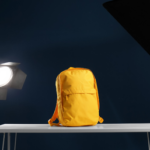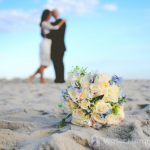What makes beach photography an interesting niche?
Beach photography tips are well loved because everyone likes a beach trip–especially taking photos of the sun, sand, and sea. Even if you’re not a surfer or a sunbather, walking on the sandy beach is a wonderful experience.
There’s something about the sense of renewal that’s always there; as the tide flows and ebbs, the waves continually wash and hit the sand. Going to the beach takes us back to nature and rejuvenates our weary spirits.
This makes the beach an ideal place for showcasing your photography skills. There are changing textures, dramatic lighting, movement, wildlife, and picturesque scenery. What else can a shutterbug wish for?
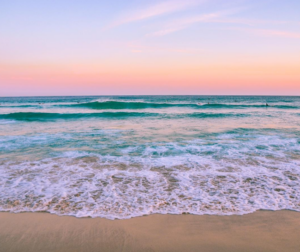
Here are our top 15 tips for amazing beach photography:
15. Have a Beach Photography Subject
Our first tip might sound like a no-brainer. Nevertheless, how many mediocre beach photos have you seen? The aspect that is missing a lot of the time in beach photography is the focal point. It doesn’t have to be any obvious thing, like an animal or a person. It would still work well for dunes, fences, shells, or even a footpath on the sea oats.
Beach photography needs something to catch the audience’s attention. It helps add more depth to the picture, too. Try to have a foreground, a background, and a middle ground. This is composition. However, sometimes when you’re at a location that’s as stunning as the beach, the basic composition can easily be overlooked.
Beach photography is no different from other landscapes. Still, you also have to exert a little more effort to add dimension.
14. Circular Polarizer
If you’ve never fitted your camera with a circular polarizer, you’re in for a treat. It is an essential tool while working around water. Nothing will make your beach photography more stunning.
A polarizer allows you to control which lightwaves are entering through your camera. With a polarizer, you can also enhance the reflection of the water, which is especially useful for sunsets.
13. Textures and Details
Textures also form perfect focal points for spectacular beach photography. The ever-changing yet beautiful ripples of sand are both fascinating and breathtaking. Wind-swept dunes offer a lot of charming details and textures that you can focus on.
The beaches also have tiny details that are often overlooked. By focusing on those details in the foreground and leaving the vast views in the background, you can add even more interest and expand the scope of your composition.

12. Slow Shutter Speeds
Slow shutter speeds paired with a powerful tripod will take your beach photography up a notch. Slow speeds can blur the waves’ motions, and even add depth to the clouds’ movements.
A benefit to doing this is that the pictures take on a fantasy-like, ethereal quality. Combine this strategy with the golden hour for beach photography that is out of this world.
11. Use Your Lens Hood
Daylight at the beach tends to be especially harsh, whether direct from the sun or bouncing off the sand. To keep the metering system of your camera accurate and to steer away from unpleasant lens flares, take your lens hood out. If you’re like a lot of photographers, you’d probably find it at the bottom of your gear bag, and it’s rarely used.
Still, it is one of the simplest items to use to improve your beach photography.
10. Avoid Midday Portraits
If you’re doing portraits at the beach, avoid doing it during midday when the sun is straight overhead. It would be too harsh, and you won’t be able to do your subject justice with the photos you’d produce. The light reflecting off the sand adds to the problems; under these conditions, shooting results in blown highlights and unsightly facial shadows.
The best choice is when the sun is setting low, just below the horizon. The light quality would be a lot better, more directional. When it’s late afternoon, however, you might want to use a fill flash or a reflector to control the light falling on your subjects.
9. Sunrise or Sunset
Sunrises or sunsets are what beach photography is all about, depending on how you look at it. Absolutely nothing is more spectacular than the sun falling into the horizon with the yellow, pink, and orange clouds just right.
The late afternoon photoshoot is a big part of the beach photography experience. The changing light is as much dynamic as it is obvious. The light intensity fluctuates every few minutes, and a good photographer will always find a way to make the most out of it.
8. The Golden and Blue Hours
The golden hour comes before sunrise or after sunset. It is the time of day, say during sunsets, when the light is soft and lovely and not too harsh. As the light is indirect, it doesn’t make unsightly shadows on people. The golden hour is literally the perfect time to shoot photographs of the beach landscape. The sky is dramatic.
The reflections of the sea are stunning, and the light is perfect for shooting subjects and people in their best light.
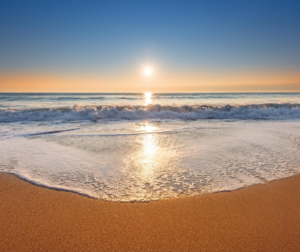
On the other hand, the blue time comes after the golden hour. The light dims and becomes bluer as the sun starts to set lower. This is the ideal time of the day to try long exposure photography. The stars are coming out, but there’s still enough light in the atmosphere to get nice images of the landscape.
7. Night Photos
Seaside venues make for a perfect location to take star photos because they appear to be away from light pollution.
Second, the scenery is ideal for stars. If the waves are calm, you could even get some reflections of the stars on the water. Try your hand at snapping wonderful Milky Way photos with a super-wide lens.
Set the aperture as wide as possible, and play with the ISO and shutter speed before you shoot. A lot of newer DSLR cameras do a pretty decent job.
6. Reflections
Check for reflections in tide pools or wet sand, regardless of what time you start your beach photography. Keep in mind that reflections add depth and interest to photographic compositions. Always find ways on how the reflections can be further emphasized through your lighting setup.
5. Off-Season Travel
One of the main challenges when going to the beach are the other tourists. Crowded beaches aren’t ideal for beach photography. You can’t control the background, and some people don’t want their pictures taken. During the peak season, it would be difficult to find a beach that you can enjoy for yourself.
It’s not always easy to do, but you can plan your travel when no one else does. Travel when the weather of a particular place you have in mind isn’t great. For example, don’t go to beach destinations during the summer months. Remember that dramatic storm clouds and fog still make for remarkable beach photography.
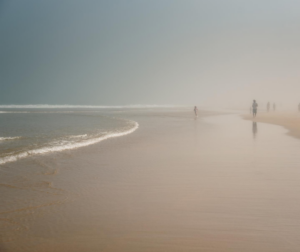
4. Add Light When Needed
Sometimes, regardless of how bright and sunny the day is, you’ll still need to add light to gain more control. Starting with natural lighting is always best, but sometimes the shadows are just too harsh. When you do a portrait photoshoot, you need to prepare yourself for this eventuality.
A reflector can soften shadow and add a touch of light. You’ll need a sturdy stand to hold it in place, though, particularly at the beach where the sea breeze can topple it. Reflectors come in gold, white, and silver.
The gold side adds warmth to the light, which matches perfectly with beach photography. Diffusers and shades can also be helpful.
3. Monitor the Background
Beaches are wide areas that it’s sometimes a challenge to monitor everything that happens within the photo frame. A lot of things, like people walking along, clumps of seaweed, trash cans, and signs, can look awkward and out of place in a picture.
Although some of these can be edited during post-production, getting it right the first time and paying attention while shooting, is much easier.
2. Break Out Your Drone
Aerial beach photography is a fantastic way to shoot from a new perspective. Some of the most striking beach photography shots are captured straight down. It has no horizon, so it relies entirely on lead lines, as well as on other elements of the composition.
1. Keep it all Clean
None of your costly equipment like the beach as much as you do. Sand comes in and messes up nearly everything—add that to the moisture, corrosive salt, and hot temperatures in your environment. Always have an air blower in your bag and a few lens clothes to keep everything clean and sand-free.
Conclusion
There are as many beach photography styles as there are beaches all over the world. Beaches are beautiful places that connect people together.
The universal fact is that people go to beaches for rest and relaxation. Use your beach photography to share a little bit of that natural beauty with those who can’t travel, or to inspire people who never thought of doing so.
Update your online photography portfolio regularly by adding recent travel photos. Your website is your advertising gateway to the world and your first contact with future clients. Here is a great article on how to build an effective photography portfolio online.






